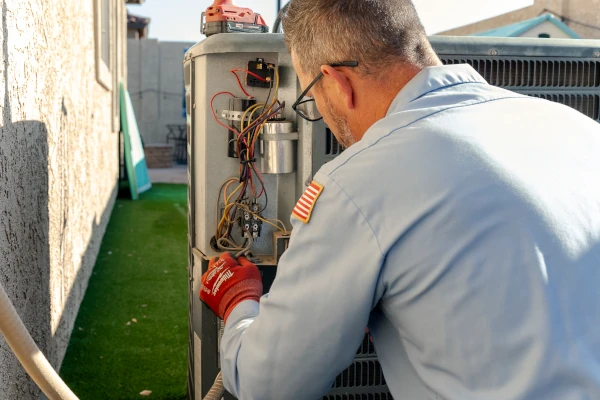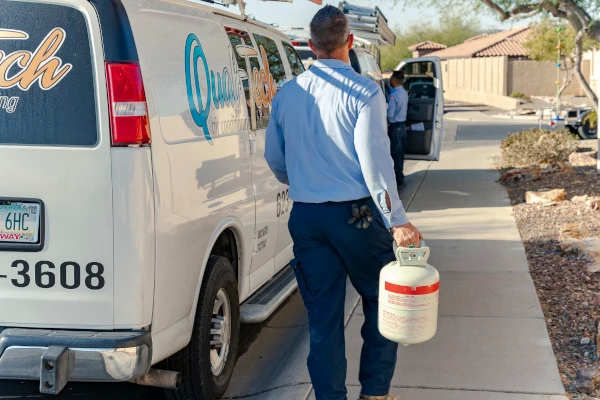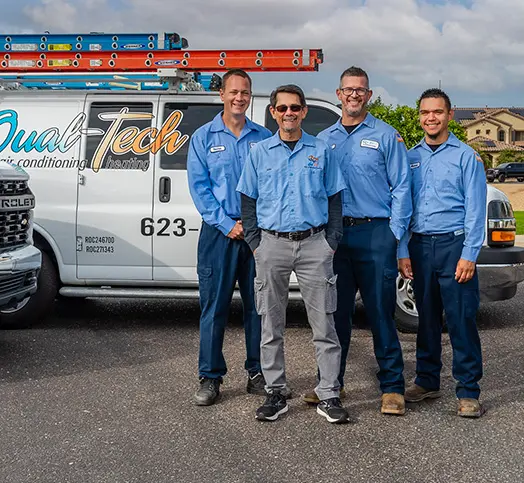Is your AC suddenly blowing warm air, making strange noises, or refusing to turn on altogether? You’re not alone. As summer temperatures rise, so do the chances of your air conditioner needing a repair.
Whether it’s a quick fix or something more serious, understanding the average cost of common AC repairs can help you make informed decisions—and avoid sticker shock when calling in a technician.
In this guide, we’ll break down the seven most frequent AC issues, what they typically cost to repair, and how likely each one is to happen. Let’s take a closer look at what might be going wrong.
Quick Answer: The average repair cost for AC repair in Arizona is about $450.
Most AC repair issues are relatively inexpensive, and include the most common AC components that fail, such as capacitors, contactors, fan motors, or refrigerant leaks on older units. AC repair costs in Arizona are also affected by the age of the system.
What Are The Most Common AC Issues?
#1-Capacitor Replacement
Average Cost: $100 - $300
Frequency: Very Common
 The capacitor is a small but essential part of your AC system. It helps power up the compressor and fan motors, allowing the unit to start and run efficiently. When a capacitor starts to fail, your AC may struggle to turn on or shut down unexpectedly. Capacitor replacements are very common. They often wear out because of heat, age, or power surges. Signs you might need a new capacitor include:
The capacitor is a small but essential part of your AC system. It helps power up the compressor and fan motors, allowing the unit to start and run efficiently. When a capacitor starts to fail, your AC may struggle to turn on or shut down unexpectedly. Capacitor replacements are very common. They often wear out because of heat, age, or power surges. Signs you might need a new capacitor include:- AC won’t start at all
- Clicking or buzzing sounds from the outdoor unit
- AC starts, but stops quickly (short cycling)
- Weak airflow or warm air from vents
#2-Contactor Replacement
Average Cost: $150 - $350
Frequency: Common
The contactor is a switch in your outdoor AC unit that controls the flow of electricity to the compressor and fan motor. When it fails, your system may not power on at all—or it might run inconsistently. This repair is fairly common, especially in systems that are more than five years old or have experienced power fluctuations or lightning strikes. Signs you might need a new contactor include:
- AC won’t turn on
- System randomly shuts off or won’t stay running
- Audible clicking but no cooling
- Burned or melted appearance on the contactor
#3-Refrigerant Leak & Recharge
Average Cost: $500 - $2500
Frequency: Common
 Refrigerant is the substance your AC uses to absorb heat and cool your home. If there’s a leak in the refrigerant lines, your system can’t operate efficiently—and in some cases, it can stop cooling entirely. Refrigerant leaks are more likely in older systems, especially those with worn fittings or corrosion in the coils. This is a moderately common repair, but it can be one of the more expensive ones depending on the leak’s location and the type of refrigerant your system uses.
Refrigerant is the substance your AC uses to absorb heat and cool your home. If there’s a leak in the refrigerant lines, your system can’t operate efficiently—and in some cases, it can stop cooling entirely. Refrigerant leaks are more likely in older systems, especially those with worn fittings or corrosion in the coils. This is a moderately common repair, but it can be one of the more expensive ones depending on the leak’s location and the type of refrigerant your system uses.
Several factors influence the cost of AC repairs. The age and brand of your system can affect part availability and pricing, especially for older or high-efficiency models. Labor rates vary by region and may increase for emergency or after-hours service. The type of refrigerant used—particularly outdated options like R-22—can also raise costs. Finally, unit accessibility plays a role; systems located in attics or rooftops may require more time and effort to service.
Signs of a refrigerant leak include:
- Weak or warm airflow
- Hissing or bubbling noises near the indoor unit
- Ice forming on refrigerant lines or evaporator coil
- Higher energy bills without explanation
#4-Blower Motor Repair or Replacement
Average Cost: $300 - $900
Frequency: Common
The blower motor is responsible for pushing cooled air through your ductwork and into your home. When it fails or starts to wear out, you may notice airflow issues or uneven cooling throughout your space. Blower motor problems are common, especially in systems that have run with dirty air filters or haven’t been maintained regularly. Depending on the motor type and severity of the issue, repair or full replacement may be needed. Signs of a blower motor issue:
- Weak or no airflow from vents
- AC is running, but rooms aren’t cooling
- Loud humming, grinding, or squealing noises
- Burning smell coming from vents or air handler
#5-Evaporator Coil Replacement
Average Cost: $2000 - $4000
Frequency: Uncommon
The evaporator coil sits inside your indoor unit and is responsible for absorbing heat from the air inside your home. When this coil becomes corroded, damaged, or clogged, your AC can’t cool properly. Replacing an evaporator coil is one of the more expensive AC repairs and is usually only necessary in older systems or those with chronic maintenance issues. While not the most common repair, it’s a serious one when it happens. Signs of a failing evaporator coil:
- Warm air blowing from vents
- Frequent refrigerant recharges
- Ice buildup on the coil or refrigerant lines
- Musty or moldy smells from vents
#6-Thermostat Replacement
Average Cost: $200 - $600
Frequency: Very Common
 The thermostat acts as the control center for your air conditioning system, telling it when to turn on and off based on the temperature you set. When a thermostat malfunctions, your AC might not respond properly—or at all. This is one of the most common and affordable repairs, and in many cases, it’s the first thing a technician checks when diagnosing cooling issues. Signs of a faulty thermostat include:
The thermostat acts as the control center for your air conditioning system, telling it when to turn on and off based on the temperature you set. When a thermostat malfunctions, your AC might not respond properly—or at all. This is one of the most common and affordable repairs, and in many cases, it’s the first thing a technician checks when diagnosing cooling issues. Signs of a faulty thermostat include:
- AC won’t turn on or off
- Inaccurate room temperature readings
- System short cycles (turns on and off too frequently)
- Unresponsive screen or buttons
#7-Drain Line or Pan Cleaning/Repair
Average Cost: $75 - $250
Frequency: Very Common
The drain line and pan remove the condensation your AC produces as it cools the air. Over time, these can become clogged with dirt, algae, or mold, causing water to back up and potentially leak inside your home. This is a very common issue, especially in humid climates or if your system hasn’t been serviced regularly. Signs you need drain line or pan maintenance include:
- Water pooling around your indoor unit
- Musty or moldy odors near vents or the AC unit
- Frequent system shutdowns to prevent water damage
- Visible algae or slime buildup
Factors That Affect All AC Repair Costs
Equipment Age, Brand, and Refrigerant Type
 The age and brand of your AC unit play a significant role in repair costs. Older systems often require parts that are harder to find, leading to higher prices and longer wait times. Additionally, certain brands with specialized or proprietary components can increase costs due to part availability. Another major factor is the type of refrigerant your system uses. Older units often rely on R-22 (Freon), which is no longer produced and is much more expensive to replace. Newer models typically use R-410A refrigerant, which is more readily available and less costly to service.
The age and brand of your AC unit play a significant role in repair costs. Older systems often require parts that are harder to find, leading to higher prices and longer wait times. Additionally, certain brands with specialized or proprietary components can increase costs due to part availability. Another major factor is the type of refrigerant your system uses. Older units often rely on R-22 (Freon), which is no longer produced and is much more expensive to replace. Newer models typically use R-410A refrigerant, which is more readily available and less costly to service.
Labor Costs and Accessibility
Labor rates vary widely depending on where you live. Urban areas or regions with a higher cost of living usually charge more for technician time. Emergency or after-hours repairs—such as nights, weekends, or holidays—can come with premium fees. Another consideration is how accessible your AC system is. Units installed on rooftops, in tight crawl spaces, or other hard-to-reach locations often require more time and effort to service, which adds to the labor costs.
Scope and Complexity of Repairs
Sometimes what seems like a simple repair can reveal deeper issues, increasing both parts and labor expenses. The extent of damage directly affects the final price; more complex repairs naturally require more time and specialized skills. It’s important to have a thorough inspection to avoid unexpected costs and to discuss repair options with your technician to find the most cost-effective solution for your situation.
AC repairs can range from simple thermostat fixes to costly evaporator coil malfunctions, but understanding the most common problems and what they typically cost can help you plan ahead, and get an idea of what kinds of expenses you should plan for, as well as how preventative maintenance can help reduce the likelihood of a repair.





